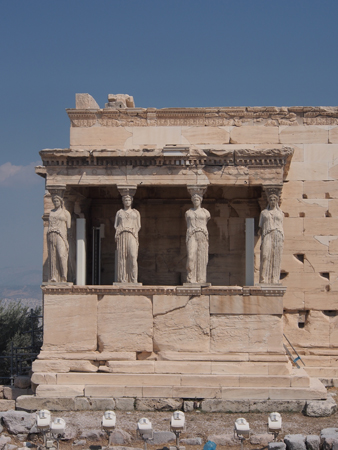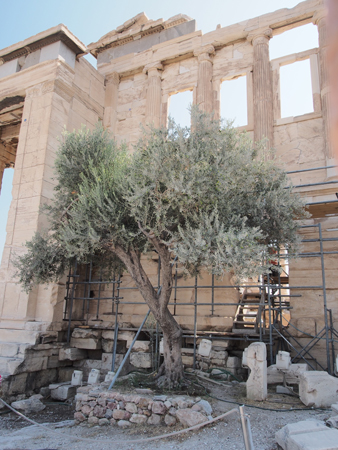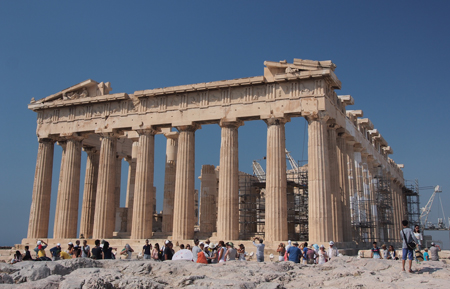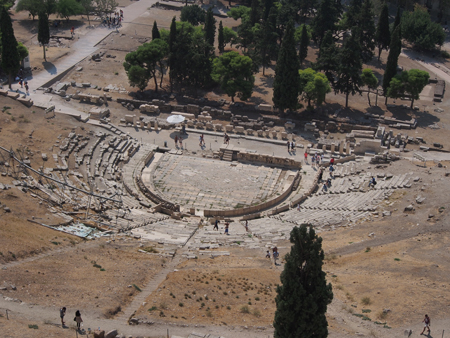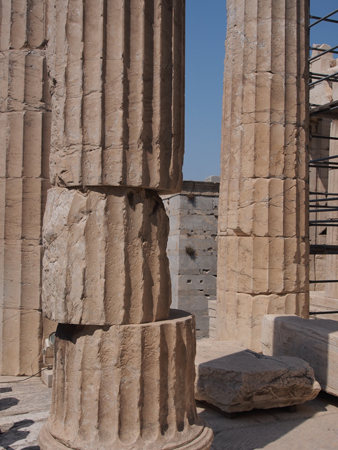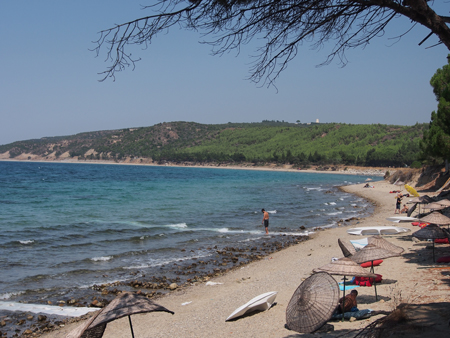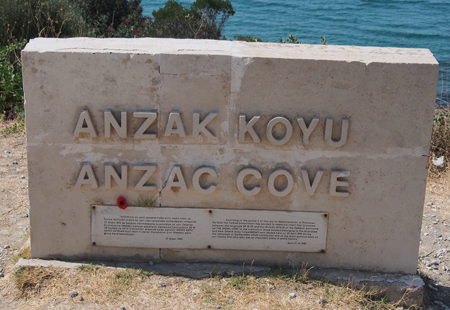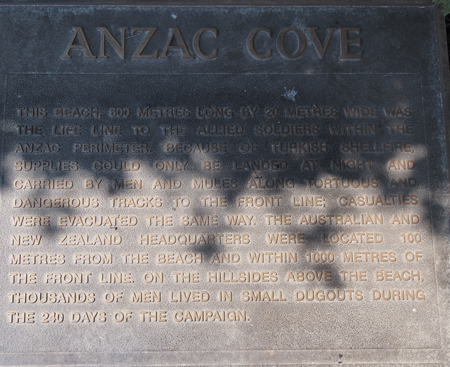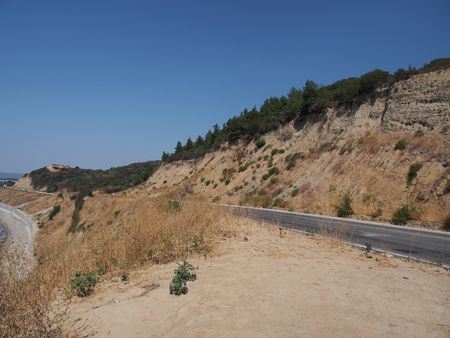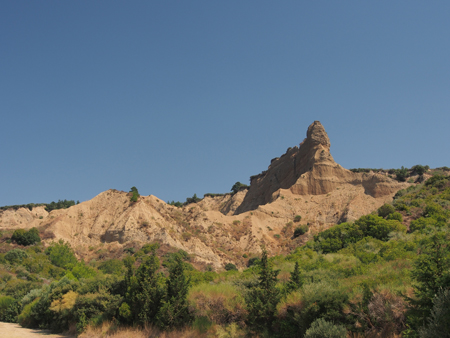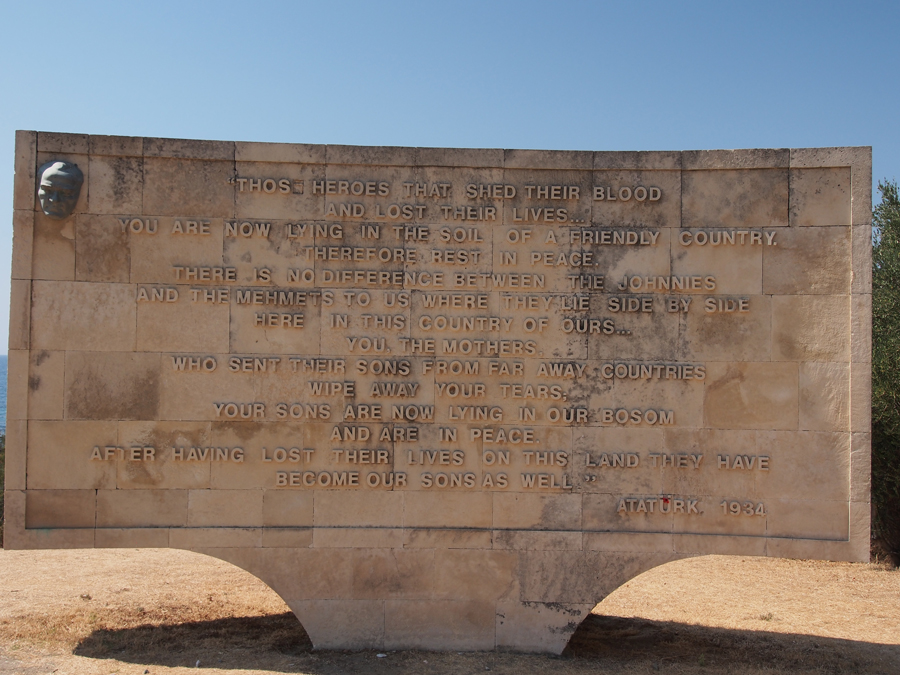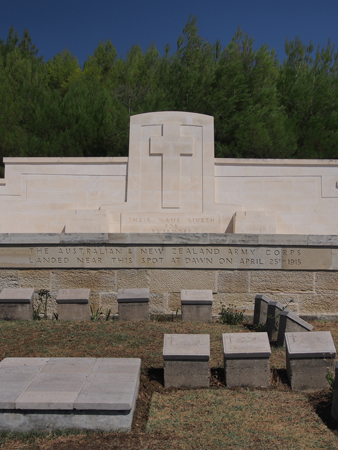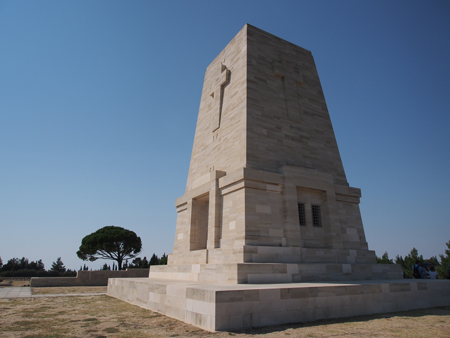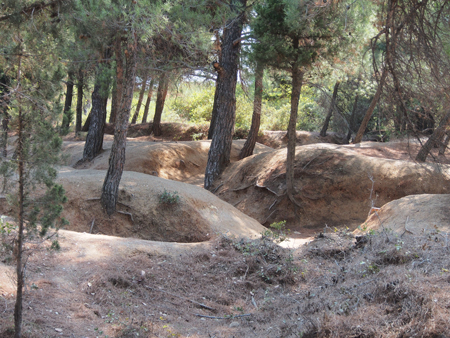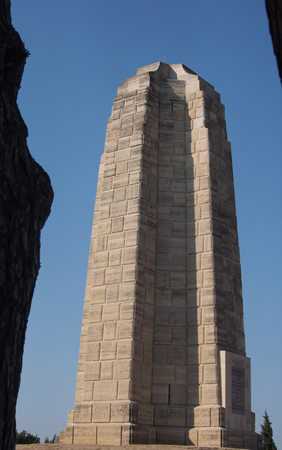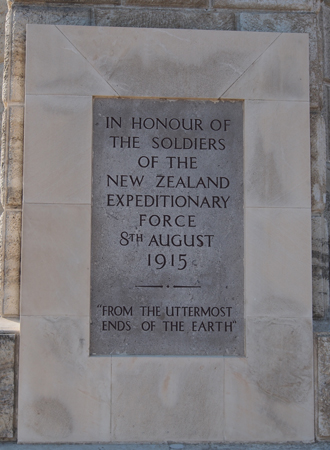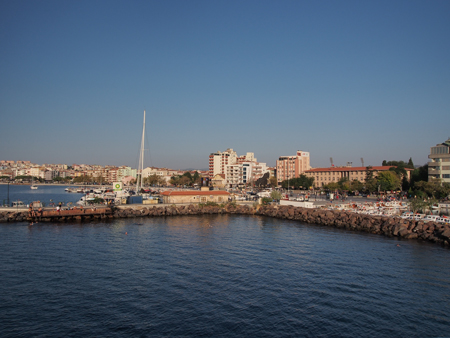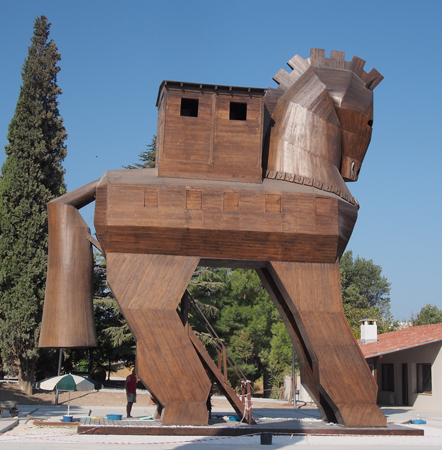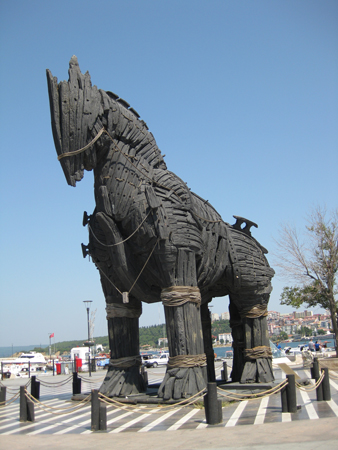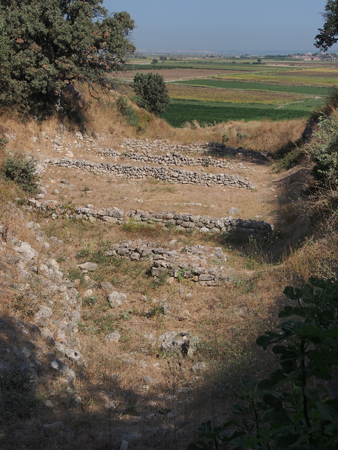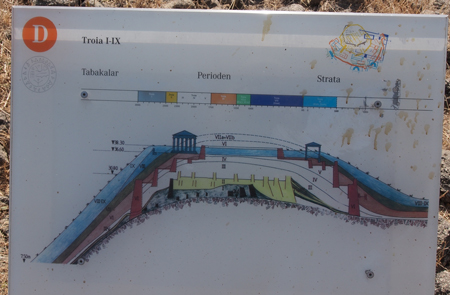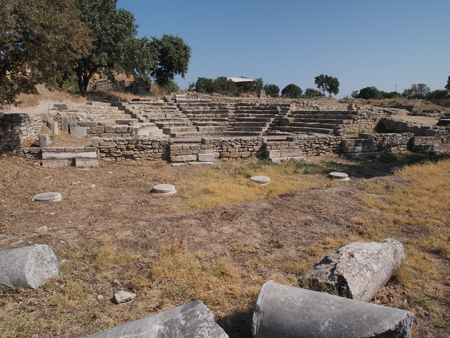Sat. & Sun., 8/2-254/13 - Piraeus and Athens
After breakfast we disembarked the Aegean Odyssey at 8:30 AM and headed out for several days on our own. We got a taxi outside the ship terminal. The driver was nice, took us directly to the Metropolitan Hotel, and even spoke a little English. The ride only cost 10 Euros. We were expecting it to cost 20 Euros.We caught the 10:15 shuttle (a big new coach) into the Syngrou Plaza across from the Parliament Building and walked around to get reoriented to the Acropolis, historic ruins, museums, and shops. We ate lunch at a cafe we ate at in 2009 (one gyro was big enough for both of us) and connected to the Internet to catch up.
For dinner, we walked to the Arseni's Restaurant, a favorite place with outside seating and traditional food cooked by "Mama." It was just as good and pleasant as we remembered it.
Sunday, we took the shuttle and the driver was nice enough to drop us at Hadrian's Arch, much closer to the Acropolis than the usual bus stop. We spent a couple hours wandering around the Acropolis - it is a magical place - and then descended to the Ancient Agora to wander there.
Temple of the Erechtheion - Porch of the Caryatids (Maidens)
|
Sacred Olive tree (replanted many times, of course) - part of the myth of Poseidon and Athena competing for the control of Athens. Poseidon threw his trident into the earth and saltwater bubbled out. Athena threw her spear and an olive tree grew from the spot. People could live on olives but not on a saltwater fountain so Athena won.
|
Parthenon |
Theater of Dionysus
|
Interesting reconstruction
|
After our wanderings, we got ice cream (coconut with chocolate chips and mocha, and chocolate/vanilla with brownie) to cool us off and revive us after our three hours of walking. We also had time for a beer before catching the 2:30 shuttle back to our hotel.
|
Mon., 8/26/13 - Athens to Istanbul, Turkey
We ate breakfast at 6:30 at our hotel buffet and took a taxi to the airport (40 Euros). Turkish Air flew us to Istanbul - an hour and 15-minute flight with lunch and beverage service. Another taxi (30 TL) got us to our Istanbul hotel, the Armada, by 1:30. We were again able to check right into our room.
We waited for the heat of the day to subside before venturing out on our own. Then we walked out around the Sultanahmet area remembering where things were located from our 2009 trip. We walked from our hotel around the Blue Mosque, the Hippodrome and Obelisks, the Roman Cisterns, and Hagia Sofia. We found the street with the sidewalk restaurants but could not identify the one we liked so well four years ago. It must have changed owners. We did have two very nice dinners for 75 TL ($38 US). I had stuffed, grilled eggplant (eggplant on a skewer with lamb meat balls), rice, French fries, grilled peppers, and a puff pastry cup with red lettuce for garnish. Marge had a lamb, mushroom, onion, and peppers baked casserole so hot it bubbled for many minutes at the table. This came with bread and pita, humus, and salsa, two beers, and bottled water. It was all very good and we cleaned our plates.Tues., 8/27/13 - Istanbul to Gallipoli to Çanakkale
We had an early pick-up time for our two-day excursion to Gallipoli and Troy. It was too early for the Armada Hotel included breakfast so the staff prepared us each a big plate covered in plastic wrap with cheese, olives, tomato, cucumber, a pot of honey, a basket of brown bread, coffee, and orange juice. They had to turn the lights on in the lobby for us to sit and enjoy the special meal. It was very nice of them.
A van picked us up at 6:30 AM and drove to several other in-town hotels to pick up five more couples. We drove toward Gallipoli and stopped at 7:30 AM for a rest, at which time another 15-passenger van join us for the tour. We arrived in Eceabat for lunch at 11:30 AM.
Our group split up depending on which tours each was taking. All were doing Gallipoli and then some were going to Troy, some on a boat ride, some back to Istanbul that night, and some on to Kusadasi. It was all well choreographed.
We went on the ANZAC Gallipoli tour in the heat of the afternoon (over 100° F) with a van mostly full of Aussies - there were two people from South Africa and us. The action of the ANZAC forces in WWI is such a big thing that this trip is like a pilgrimage for the Aussies and New Zealanders. The Gallipoli attacks were a military disaster that led to almost 188,000 allied casualties, but it solidified the countries of Australia and New Zealand as nations. They are very proud (and have every right to be) of the support they provided in WWI.
(The following summary is quite instructive, especially if you are not familiar with Gallipoli and WWI - or you may skip to the photos.) The British convinced the French that the stagnant fight on the Western Front (in France) might be broken by invading the "soft underbelly" of the German, etc. forces and (ultimately) moving up through Turkey into Austria-Hungary, etc. They also wanted to capture Constantinople to control access to the Black Sea for the Russians (allies, at the time). The British and French staged a naval battle with three lines of battleships entering the Dardanelles Strait on March 15, 1915. The Turkish navy set up mines in the channel and the cannons from the forts on either side of the narrows at Çanakkale sank or burned six of the 18 battleships there. It was the first Turkish (Ottoman) naval victory of the war. The Brits made crucial mistakes in this attempt. Since that plan failed, landings were planned to try to seize the high ground on the Gallipoli Peninsula. British and French troops attacked the point (Cape Helles) and the ANZACs landed and attacked from the west on April 25, 1915. 15,000 ANZAC troops who had trained in Egypt landed but were put ashore one mile north of the sandy beach and gentle slopes to the higher ground. This is one more of the crucial mistakes the British officers made in this campaign. From the ANZAC Cove they attacked up Shrapnel Gully to the high point. 160 Turks retreated and in two days returned, led by Mustafa Kemal (who later would become Ataturk) and pushed the Allies back. The ANZAC troops had no officer in charge at this point and the British leaders were headquartered two miles away on an island. On the shore at the cove all the Allied supplies, including water transported from Egypt, were stored. Donkeys were used to transport wounded back to hospital ships, one of which was sunk there in the cove and the wreckage can still be seen.
Kemal commanded the Turkish fighters and when they ran out of ammo, he had them fasten their bayonets and defend their homeland. On May 29 all of the students from Istanbul University were sent to the front lines after one week of training! They were all slaughtered in one day. There were no graduates of the university for four more years.
This senseless killing went on for 8 1/2 months until the Brits decided to evacuate Gallipoli in December. The evacuation lost no additional lives but 174,828 Turks and 187,859 Allied troops, including 35,623 ANZACs, were casualties on Gallipoli. The dead were buried in mass graves or cemeteries. Many (most) were never identified.
Kemal, after the war, became the ruler of the new Turkish government and was named Ataturk, Father of the Turks. He is the one who modernized Turkey and created the only Islamic country with a western democratic government and culture. At Chunuk Bair, the high point of the peninsula, Kemal was leading the front line in the trenches when a bullet hit him above his heart. The shrapnel hit his pocket watch in his upper pocket and saved his life. He died in 1938 of cirrhosis of the liver - he was a heavy drinker. (Link to more Gallipoli information.)
Brighton Beach - where ANZACS should have landed
|
|
|
|
Bluffs above ANZAC cove
|
High ground inland from ANZAC cove |
We had many stops around the battlefield: the ANZAC Commemorative Site (which is planning for a big ceremony on April 25, 2015, the 100th anniversary); Ari Burnu with the plaque of Ataturk's speech; the north and the south beach cemeteries; Lone Pine Australian Memorial; the trenches of both armies - some of which are only 8 meters apart.
|
|
Plaque at Ari Burnu - Ataturk's speech
|
|
Beach Cemetery
|
Lone Pine Memorial - Australia |
Lone Pine Memorial - Australia
|
WWI Trenches |
Turkish Memorial to their 57th Regiment
|
Statue of the last Turkish survivor and his great-granddaughter |
Chunuk Bair - New Zealand Memorial |
Chunuk Bair - New Zealand Memorial
|
We left the national park and took the passenger ferry from Kilitbahir to Çanakkale where we checked into the Helen Hotel for one night. We were hot and tired but walked along the waterfront and had a Turkish dinner at Assos Cafe. We had "meat on tile" (chicken or beef baked in a clay pot with red and green peppers), salad, and French fries. It was good.
|
Çanakkale waterfront
|
Wed., 8/28/13 - Çanakkale to Troy to Istanbul
This morning we had a Turkish buffet breakfast at our hotel and then got into vans to tour the site of Troy. We waited 45 minutes at one hotel for four Aussies on our tour who had to wait for someone from the Australian Embassy to come and let them vote in their national election which was today. Aussies must vote or pay a fine.
It was a 30-minute ride from Çanakkale to the ruins of Troy I to IX. Every 100 or so years an earthquake or fire toppled and destroyed the existing city. People left and then a new generation would return and rebuild a city above the old one.
In the 1880's Heinrich Schliemann, a German treasure hunter, reasoned that the ancient city of King Priam had to be located here. He used a bulldozer and dug trenches destroying much but finding 8800 items of gold. He stole them and put 65% of them in the Berlin Museum from where it all disappeared in 1941. Funny how it is all now in the Moscow Museum (Pushkin).
Troy I was built 3500 years ago and had a population of about 150. By the time of Priam and Troy VI or VII, there must have been around 10,000 people. Troy IX was abandoned around 500 CE because of malaria.
We looked at the ruins - only 10% have been excavated. The oldest walls were built of limestone at the base and with wood and mud brick above. The Romans used sandstone and then marble and the stones were well carved and shaped. The town had around 800 wells so water was no problem. As Troy VII to IX were built, many houses were outside the double city walls. When under siege, people moved inside the walls and built up houses on any available space.
We looked at the replica of an imaginary wooden horse and heard three stories of what ancient writings may have been describing. The Iliad described a horse tall enough to use the head as a battering ram, but that would not have worked because there was no way to run up to the curved walls.
Versions of the Trojan Horse
|
Versions of the Trojan Horse |
We were there
|
Schliemann’s original trench |
The nine levels of Troy |
Levels marked at the "dig"
|
Ruins |
Roman Amphitheater
|
Stop in Turkish
|
At 11:30 AM we were dropped back in Çanakkale to wait five and a half hours to get our ferry across the Dardanelles to join the group that toured Gallipoli today and be driven back to Istanbul. We spent part of the time watching an hour and a half documentary on the Gallipoli campaign. The electricity went out twice (too much air conditioning on the grid) so we didn't see the whole movie, but it was interesting and informative. We went back into the heat to get a bite to eat and because it was only 4:30 we could only get Turkish pizza. (The Turks eat very late.) Turkish pizza is a small bread roll with cheese, etc. in the middle. They are good.
|
| Return to Top | Return to Itinerary | Return to Trips page to view other trips | Return to Dreamcatcher Home Page |
